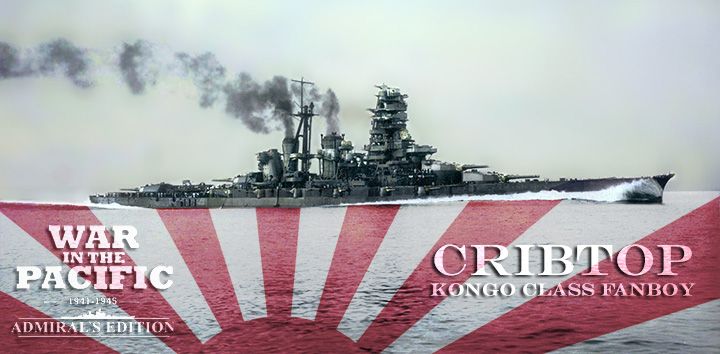Nemo121
Posts: 5821
Joined: 2/6/2004
Status: offline

|
I'm catching up on this AAR ( not reading John 3rd's side ) and thought I would comment as I came across posts in January which were interesting. CR, if you don't want me to comment just let me know and I'll desist.
1. Deep battle was raised by Princeps and then Alfred commented as follows: quote:
would quickly point out that the current KB operations off New Zealand is not a "deep battle" operation. From a strategic POV, he would not be complimentary of the overall Japanese play.
Precisely. Haring off into the deep in order to chase down some strategically meaningless frippery isn't deep battle, it is the worst sort of flash over substance, tactical showboating ever. John3rd doesn't do strategy and deep thought. His personality is the key to understanding his play as it dictates much of his play.
As to what he is emulating with some of these thrusts... It isn't so much Tukhachevsky at Frunze or even Budenny during the 1920 Polish campaign getting bogged down at Lviv while the strategically decisive battle was taken place at Warsaw... No he harkens back to a much earlier time. It reminds me very much of Rameses II at Kadesh. He is forward with the Amun division dreaming of glory and mentally composing the poem and bulletin which will proclaim his capture of Kadesh when he realises that the Hittites are across the hill. He calls for the Seth, Re and Ptah (sic?) divisions to come up but as they take their time he gloriously confronts the enemy himself ( as the Amun division crumbles ). At the end of the day he has a draw from the battle, a great narrative of how awesome and daring he was in charging the Hittite lines when he was abandoned by the Amun division and the Amun division is totally and utterly trashed.... and its destruction was utterly avoidable and unnecessary.
The aftermath is always much like Kadesh also. There is slaughter on the field, much is made of the clamour and flashing of sunlight off armour and weaponry but, at the end, whether one considers it a win, draw or a loss, there isn't the logistically realistic underpinning to make it stick and so, as with Rameses II he retreats back to Egypt, writes his poem and bulletin and posts them at his temples at Luxor, Karnak and Abydos ( and elsewhere but I can't remember their names right now - the temples, of course being analogues to the forum threads ) and relies on the grandeur of his monuments to bear testimony to the grandeur of his "victory".
I've outlined a little for those who may not be familiar with the Battle of Kadesh. Bottom line though, I've used this example before because there really are striking similarities between Rameses II's conduct of the battle of Kadesh ( and his strategic and operational failures ) and John3rd's conduct of this and other campaigns. What's also helpful is that he can be relied upon to make the same errors time and again since they come from his personality and not from an error in assessment of enemy intentions or capabilities. I'd strongly suggest a quick refresher with the battle of Kadesh since John3rd emulates Rameses II's handling of his forces at Kadesh time and time and time again. Budenny at Lviv is another good example but Kadesh is smaller, clearer and more easily digested since its scale is tactical and operational and not grand strategic like Lviv was.
Obviously this is just my opinion.
2. A rather interesting discussion of the applicability of Deep Battle to naval tactics -harking back to Drake but, rather surprisingly, without any mention of Mahan which is unusual given the subject matter and nationalities of most contributors.
Bullwinkle makes some interesting points re: the differences between land warfare and naval warfare and the lack of "terrain features" in naval warfare while Crackaces talks of the grand strategic level ( off-map resources, reinforcement schedules etc... what the Soviets of the time would have termed grand strategic or national policy level matters ).
Two quick points re: this interesting discussion:
a) If one views islands as fortified terrain and chains of islands which project combat power such that it interlinks with projected combat power from other islands as a front line then one can view the Pacific as a front line with secondary lines, tactical depth ( that range into no-man's land or behind your lines to which the enemy's tactical bombers can operate ), operational depth ( that range into which an operation can be mounted without transitioning into your strategic depth - usually into the 1st or 2nd line of defence and no farther ) and strategic depth ( everything else ).
Deep battle is concerned with engaging the enemy geographically and temporally throughout their entire depth ( tactical, operational and strategic ) using all modalities ( the presence of force, the absence of force, the confirmation and/or denial of intelligence and the creation of maskirovka ) to both misdirect and direct the enemy such that you can most efficiently break into their strategic depth, dislocating their tactical and operational defences and forcing a strategic redeployment of enemy forces along, ideally, the entire zone of contact between your forces and theirs.
In simple terms, if you can hold Guadalcanal and can take the Marianas without getting hung up around Rabaul and Truk then why not do so? You'll render Rabaul and Truk irrelevant ( so long as your logistics are defensible ).
The key though with Deep Battle is that it is about engaging ( through combat, misinformation, misdirection etc etc ) all layers of the enemy's dispositions in order to shape the battlefield as you wish it to be and then striking at something strategically vital which dislocates their tactical and operational defences entirely. Does that mean you skip the fight in the tactical or operational zone? No, it just means you don't allow yourself to get bogged down there - the Soviets did this through the use of echelons all the way up to Front and Strategic Direction level ( which could be responsible for releasing a Tank Army into NATO's operational depth in pursuance of a strategic objective ) while the US sought to do this with AirLand Battle ( the engagement of Soviet echelons through their tactical, operational and strategic depth through the use of ground combat units, helicopters, operational and strategic airstrikes, A-teams and stay-behinds lasing Copperheads onto any tank with a really large aerial --- this was the US version of deep battle ) and the teaching of auftragstaktiken and "manoeuvre warfare".
Obviously everyone can view it through whatever prism makes most sense to them but, for me, those 4 layers ( grand strategic/national policy level, strategic, operational and tactical ) as well as the Soviet emphasis on controlling both what is and isn't seen/done etc ( as opposed to the Western orthodoxy of just focussing on what isn't seen/done ) are sensible, clear and easy enough to create a rubric around.
When push comes to shove though ---- whatever works for you works for you. No one person has a monopoly on the "right way" to do anything ( in this game or in life ).
3. Crackaces: quote:
Of course most of the time I am thinking of John's moves at the level WHAT IS HE THINKING !!!????!!!!
LOL! Also, ny59giants is correct in post 687. Strong traits, strong.
< Message edited by Nemo121 -- 4/18/2013 1:21:49 AM >
_____________________________
John Dillworth: "I had GreyJoy check my spelling and he said it was fine."
Well, that's that settled then.
|
 Printable Version
Printable Version
























 New Messages
New Messages No New Messages
No New Messages Hot Topic w/ New Messages
Hot Topic w/ New Messages Hot Topic w/o New Messages
Hot Topic w/o New Messages Locked w/ New Messages
Locked w/ New Messages Locked w/o New Messages
Locked w/o New Messages Post New Thread
Post New Thread